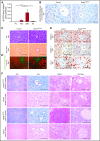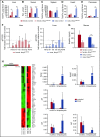Angiocrine Bmp2 signaling in murine liver controls normal iron homeostasis
- PMID: 27903529
- PMCID: PMC5291964
- DOI: 10.1182/blood-2016-07-729822
Angiocrine Bmp2 signaling in murine liver controls normal iron homeostasis
Abstract
Microvascular endothelial cells (ECs) display a high degree of phenotypic and functional heterogeneity among different organs. Organ-specific ECs control their tissue microenvironment by angiocrine factors in health and disease. Liver sinusoidal endothelial cells (LSECs) are uniquely differentiated to fulfill important organ-specific functions in development, under homeostatic conditions, and in regeneration and liver pathology. Recently, Bmp2 has been identified by us as an organ-specific angiokine derived from LSECs. To study angiocrine Bmp2 signaling in the liver, we conditionally deleted Bmp2 in LSECs using EC subtype-specific Stab2-Cre mice. Genetic inactivation of hepatic angiocrine Bmp2 signaling in Stab2-Cre;Bmp2fl/fl (Bmp2LSECKO) mice caused massive iron overload in the liver and increased serum iron levels and iron deposition in several organs similar to classic hereditary hemochromatosis. Iron overload was mediated by decreased hepatic expression of hepcidin, a key regulator of iron homeostasis. Thus, angiocrine Bmp2 signaling within the hepatic vascular niche represents a constitutive pathway indispensable for iron homeostasis in vivo that is nonredundant with Bmp6. Notably, we demonstrate that organ-specific angiocrine signaling is essential not only for the homeostasis of the respective organ but also for the homeostasis of the whole organism.
© 2017 by The American Society of Hematology.
Figures


Comment in
-
Liver sinusoidal endothelial cells as iron sensors.Blood. 2017 Jan 26;129(4):397-398. doi: 10.1182/blood-2016-12-754499. Blood. 2017. PMID: 28126953 No abstract available.
Similar articles
-
Endothelial cells produce bone morphogenetic protein 6 required for iron homeostasis in mice.Blood. 2017 Jan 26;129(4):405-414. doi: 10.1182/blood-2016-06-721571. Epub 2016 Nov 18. Blood. 2017. PMID: 27864295 Free PMC article.
-
Liver Sinusoidal Endothelial Cells Suppress Bone Morphogenetic Protein 2 Production in Response to TGFβ Pathway Activation.Hepatology. 2021 Oct;74(4):2186-2200. doi: 10.1002/hep.31900. Epub 2021 Aug 24. Hepatology. 2021. PMID: 33982327
-
Bone morphogenetic protein 2 controls iron homeostasis in mice independent of Bmp6.Am J Hematol. 2017 Nov;92(11):1204-1213. doi: 10.1002/ajh.24888. Epub 2017 Sep 25. Am J Hematol. 2017. PMID: 28815688 Free PMC article.
-
Angiocrine signaling in the hepatic sinusoids in health and disease.Am J Physiol Gastrointest Liver Physiol. 2016 Aug 1;311(2):G246-51. doi: 10.1152/ajpgi.00118.2016. Epub 2016 Jun 10. Am J Physiol Gastrointest Liver Physiol. 2016. PMID: 27288423 Free PMC article. Review.
-
Hepcidin and the BMP-SMAD pathway: An unexpected liaison.Vitam Horm. 2019;110:71-99. doi: 10.1016/bs.vh.2019.01.004. Epub 2019 Feb 10. Vitam Horm. 2019. PMID: 30798817 Review.
Cited by
-
Iron, erythropoietin, and inflammation regulate hepcidin in Bmp2-deficient mice, but serum iron fails to induce hepcidin in Bmp6-deficient mice.Am J Hematol. 2019 Feb;94(2):240-248. doi: 10.1002/ajh.25366. Epub 2018 Dec 10. Am J Hematol. 2019. PMID: 30478858 Free PMC article.
-
The Intrinsic Biological Identities of Iron Oxide Nanoparticles and Their Coatings: Unexplored Territory for Combinatorial Therapies.Nanomaterials (Basel). 2020 Apr 27;10(5):837. doi: 10.3390/nano10050837. Nanomaterials (Basel). 2020. PMID: 32349362 Free PMC article. Review.
-
Transferrin receptor 2 controls bone mass and pathological bone formation via BMP and Wnt signaling.Nat Metab. 2019 Jan;1(1):111-124. doi: 10.1038/s42255-018-0005-8. Epub 2019 Jan 7. Nat Metab. 2019. PMID: 30886999 Free PMC article.
-
Endoplasmic reticulum stress controls iron metabolism through TMPRSS6 repression and hepcidin mRNA stabilization by RNA-binding protein HuR.Haematologica. 2021 Apr 1;106(4):1202-1206. doi: 10.3324/haematol.2019.237321. Haematologica. 2021. PMID: 32703788 Free PMC article. No abstract available.
-
Control of Systemic Iron Homeostasis: Insights Gained from Studying Mouse Models.Adv Exp Med Biol. 2025;1480:103-118. doi: 10.1007/978-3-031-92033-2_8. Adv Exp Med Biol. 2025. PMID: 40603787 Review.
References
-
- Géraud C, Schledzewski K, Demory A, et al. . Liver sinusoidal endothelium: a microenvironment-dependent differentiation program in rat including the novel junctional protein liver endothelial differentiation-associated protein-1. Hepatology. 2010;52(1):313-326. - PubMed
Publication types
MeSH terms
Substances
LinkOut - more resources
Full Text Sources
Other Literature Sources
Medical
Molecular Biology Databases
Miscellaneous

